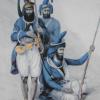Search the Community
Showing results for tags 'weapons'.
-
was the bagh nakh weapon created by Sikhs? I'v read that Sikhs invented the bagh nakh but then other places iv read that the marathas did? shivaji maratha famously stabbed a muslim invader with a bagh nakh so its more associated with the marathas. i think the weapon is really unique and amazing i first saw one at the sikh empire exhibition in london and i couldn't stop looking at it lol never seen anything like it and its really cool how it was inspired by leopard claws.
-
Hello, I've heard of people mention "ganga yamuna/jamuna" tulwar but I haven't heard this term before with respect to tulwars. I'm Hoping someone can explain what is meant by a "ganga yamuna/jamuna" tulwar. Is this a type or class of tulwar, does it refer to a place where quality swords were made? Does it mean the sword steel is wootz or pattern-weld damascus or a particular type of steel? What characteristics identify a "ganga yamuna/jamuna" tulwar? What is the approximate cost for purchasing Please share pictures of your "ganga yamuna/jamuna" tulwars, or if you have access to such pictures. And write your thoughts about these weapons, what you like about them, how they handle, quality, etc. Thank you in advance.
-

Jagmeet Singh needs to be made Tankhaiya For his Letter asking for Weapons Ban
Guest posted a topic in GUPT FORUM
ਸਿਖਮਤਵਿਚਅਕਾਲਪੁਰਖਜੀਦਾਪ੍ਰਤੱਖਦਰਸ਼ਨਗੁਰੂਗ੍ਰੰਥਸਾਹਿਬਜੀਦਾਹੈਅਥਵਾਗੁਰਾਂਸੰਤਾਂਦਾਹੈ।।ਤਥਾਹੀਭਗਵਤੀਦਾਪ੍ਰਤੱਖਧੇਇਸਰੂਪਸ੍ਰੀਸਾਹਿਬਆਦਿਕਸ਼ਸਤ੍ਰਾਂਅਸਤ੍ਰਾਂਦਾਦਰਸ਼ਨਹੈ।। In Sikhism, to view the [sargun] form of Akal Purkh you can look towards Sri Guru Granth Sahib Ji as well as Saints. Like this to the [sargun] form of Bhagvati [Devi/Chandi] for one to view weapons [shastar and astar]. https://www.manglacharan.com/home/devi-in-khalsa-dharam-shaastar https://www.manglacharan.com/home/call-to-arms-by-guru-gobind-singh-ji He's Amritdhari, it needs to get done. Just tried calling the SGPC but their phones aren't working. Will try email, if people know other organizations then do so. Many of the Sikh politicians are selling out Guru Sahib in this form, or attempting to do so by supporting these measures. ਵਾਹਿਗੁਰੂਜੀਕਾਖਾਲਸਾ।।ਵਾਹਿਗੁਰੂਜੀਕੀਫਤਹਿ।। -
wjkk wjkf, in guru gobind singh jis 52 hukams one of the hukams say that sikhs should continue on the tradition of ghor savari and shastar vidiya, but do we still need training in these areas, especially in horseback riding now that cars are available. bhula chuka kema muaf. wjkk wjkf
-
Waheguru Ji Ka Khalsa, Waheguru Ji Ki Fateh! Why is literature on Indian martial arts so rare? There are countless books on Chinese, Japanese and Korean martial arts, but probably only about 5 Kalaripayattu books, and only 4 Gatka books (two in English and two in Punjabi). The first Gatka book was published in 1936 by K. S. Akali. He refers to Gatka as a ‘sport’ and exponents as ‘players’. No association to Sikh warriorhood, etc. And the pentra doesn’t seem correct. Also, it only covers the soti; no dhal talvar, barcha, etc. Then there is Nanak Dev Singh Khalsa’s Gatka book written in the 1980s. It’s mixed with H3O-style yoga. I remember emailing the author directly back in 2000 to obtain his book, which I had read about in an old online Gatka article. He told me to forget about the book and gave me the mobile number of his new Ustad, named… Nidar Singh! In 2000, I travelled to India specifically to obtain books on Indian martial arts (previously could only find brief mentions of IMA in desi magazines and newspapers). In India, I came across large book markets. They had tons of books on school education, poetry, religion, but no Gatka books. Fortunately, though, as I was about to leave from a small store, the shopkeeper pointed to a dusty old book. He said it was titled “Lathi Shiksha”. It was an illustrated manual on quarterstaff fighting written in deep Hindi. Includes some mystical-seeming geometrical patterns. I assume they are the directions of stick-fighting forms. It was so fragile that the pages would break off if bended. No date on it, but could be from the 1940s or 50s. There is a short booklet called Shastar vidya, by Baba Gian Singh (published by Budha Dal). I believe it was first published decades ago. Most of it is full of warrior philosophy and martial verses from the Dasam Granth. There are some dagger-fighting descriptions towards the end. Then there is a 2017 book called “Shastra vidya: The Ancient Indian Martial Art of the Hindu Kshatriyas”. It’s got textual evidence (from Hindu scriptures, epics and treatises) and includes illustrations to go with the descriptions. It covers weapons like bhindipal, vajr, trishul, gada, mayukhi, dhanush, etc. But it’s not by Nidar Singh! I’m surprised Nidar Singh hasn’t brought out a book yet on Shastar vidya.
- 25 replies
-
1
-
- shastar vidya
- gatka
-
(and 6 more)
Tagged with:
-
Waheguru Ji Ka Khalsa Waheguru Ji Ki Fatteh Who can you learn shasta vidiya from apart from Nidar Singh and is in the Birmingham area?
-
VJKK VJKF Sat Sangat Ji, I had a question regarding using Shastar for training. I train with Shastar regurlarly, and on one occasion one of my friends came over while I was training. I happened to be training with my Sri Sahib/Kirpan that day and when my friend saw me he said that I shouldn't be taking my Kirpaan out of it's case like that because apparently it wants khoon(blood) when you take it out and taking it out for any other reason than bhog is beadbi. I tried telling him that I was only using it to train and that I never start without an Ardas and asking Guru ji for permission but he said I should use a different one other than my kakaar. The probelm is, I need to use my specific Kirpaan because it is the one that is always with me, so if I had to ever take it out for any combat situation (Which I hope never happens) I want to be fully functional and efficeient with my specific Kirpaan. So my question is: Is it beadbi to take out your kirpan for training, and also, does it really want blood when you take it out. VJKK VJKF
-
Report: India Remains World’S Largest Arms Buyer
Mehtab Singh posted a topic in POLITICS | LIFESTYLE
India leads global arms imports along with China and Pakistan, as US and Russia maintain dominance in exports. India remains the worlds largest arms buyer by a huge margin, even as regional rivalries spur the flow of arms to other countries in Asia, according to a report released Monday by the Stockholm International Peace Research Institute (SIPRI). India increased its arms imports by 111 percent in the past five years compared with 200408, and it now accounts for 14 percent of the worlds arms imports. The mainly Russian-supplied flow of arms to India dwarfs the imports of its regional rivals China and Pakistan, the second- and third-largest buyers. There is money, there is threat perception, and there is a willingness of exporters to supply weapons, said Siemon Wezeman, a senior researcher with SIPRI Arms Transfers Program and a co-author of the report. The United States and Russia dominate arms exports over half the market, combined but their business has diversified and shifted focus from Europe toward emerging world powers such as India, Brazil and China. Even as European imports declined by a full quarter over the past five years, the volume of global arms sales climbed 14 percent in 2009 through 2013 compared with the previous five-year period, SIPRI found. Because arms sales fluctuate year to year, SIPRI uses a five-year average to provide a more stable measure of trends. By a substantial margin, Asia witnessed the greatest growth in arms imports. The region buys 47 percent of the globes major weapons. Among the bigger importers is South Korea, which ranked eighth in that period, reflecting both the countrys burgeoning economic prowess and rising tensions with North Korea. The South has devoted its considerable defense spending to being able to detect and destroy North Korean missiles, SIPRI said. But the global arms-importing trifecta consists of three Asian countries that eye each other with constant suspicion: India, Pakistan and China. Though India went on the biggest buying spree in the world, Pakistan has boosted its weapons imports by 119 percent and now ranks third in the world behind China, which has gained a foothold in high-tech arms exports as well. Relations between India and Pakistan have been hostile since they split in 1947, a history punctuated by several wars and an ongoing border dispute in the Kashmir region, but Chinas recent efforts to expand its regional military presence are viewed as especially threatening. Chinas naval modernization is starting to infringe on the Indian Ocean, which India considers its backyard, Wezeman said. Thats why you see both countries expanding naval forces slowly and carefully toward Southeast Asia. Indias arms-buying is also explained by the countrys failure to satisfy its appetite for weaponry through domestic production. A growing India still depending on foreign companies for a substantial part of our defense needs is not a happy situation, the countrys Defense Minister A.K. Antony admitted at a defense expo in New Delhi last month. Of the worlds top 10 weapons buyers, India has the second-lowest domestic production, trailing only Saudi Arabia. Most analysts place the blame on poor infrastructure, limited real estate and civil sector corruption. But the threat of imminent war is not the only factor that motivates the hoarding of high-tech arms. India, it sees itself as a regional power, if not a world power, Wezeman said. When you have those ambitions, that requires some military powers or muscle that you can show off. Otherwise, its not really power. So prestige does play a role in weapons acquisition. Global stature also appears to motivate Brazils climbing weapons imports, despite the relative placidity of South America. With one of the world's fastest-growing economies, Brazil has sought to build on its role as the most powerful nation on the continent. As it charts that course, it has increased weapons imports by 65 percent in 2009 through 2013 versus 2004 through 2008. That includes an order for 36 combat aircraft from Sweden for $4.8 billion and four submarines from France for $9.7 billion. Brazil has announced plans to replace its aircraft carrier, the only one in South America. You ask yourself, what is that good for? It fits a prestige role much better than anything else, Wezeman said. Other regions where arms buying has picked up include the Persian Gulf (called the Arabian Gulf by some Arab nations), home to the fourth- and fifth-largest importers in the world, the United Arab Emirates and Saudi Arabia, respectively. Conflict-ridden African states like Sudan and Uganda also witnessed huge increases in 2009 through 2013 compared with the previous period. Europe, the only region to observe a sharp decline arms imports, has faced limited threats to its stability as well as a long-running eurozone economic crisis, which has contracted spending in most countries. But that all may change considering how Russia is using missile policy toward Ukraine, Wezeman said. It has already lead to discussions in Poland and Sweden about whether those countries actually have enough missiles to deal with a more assertive Russia. http://america.aljazeera.com/articles/2014/3/17/india-still-worldslargestarmsbuyerasasianrivalriesheatup.html -
"Shri Guru Gobind Singh Ji Weapons display" Weapons have traditionally played an important role in Sikh religious practice and Sikh history. here is some display of weapons of shri Guru Gobind singh ji which is placed in Anandpur Sahib
-
The Guru has ordained that his Khalsa learns the art of fighting. Singhs today have lost their fearsome reputation as 'Men of Action'. Are you ready to step up and develop Teeth and Claws which makes a Lion/Lioness true to their form? Develop the skills and confidence to defend yourself, your family and your Panth... For those NOT already learning a fighting art (our aim is not to poach or compete with others), if you have the following characteristics, you are invited to learn from the School of Elusive Fighting: Humility Politeness and respect (towards people, all faiths and all jathebandiyan/sampryada) Dedication Passion Open Mindedness Courage Hard Work Ethic Discipline DISCRETION We teach armed and unarmed fighting based on principles derived from various traditional/family fighting systems of South East Asia (predominantly, but not only, Filipino and Chinese). The Sword, Stick/Salotar, Knife are the basic weapons students learn (we move on many variations of these i.e. the fighting tabbar/axe). We also teach use of the Kara based on the same principles. The principles to use each or a combination of the above are one and the same, in essence, the art is very simple, the devil lies in the detail. Footwork, evasion, positioning, fast take downs, multiple opponent strategy and internal power generation are the core principles of the art. Street psychology and awareness and the practice of street scenario applications is also an important aspect. You will also learn old school traditional fighting exercises to develop fighting energy, fighting flexibility and fighting movement. We specialise in escapes from grabs and hold ups, so this art is highly suitable for bibiyan/females. The art does not rely on the training of strength and speed, but more so, body mechanics and timing. The classes are kept small and operate as family environments, so full respect for all students is assured. No type of bad behaviour is tolerated. If you are DEADLY SERIOUS and interested in learning, then drop us an email on elusivefighting@gmail.com please do not post any questions here. Please do not contact us ‘out of interest’. We are only interested in speaking to those who are ‘ready’ to commit and learn. Commitment of 1 class a week is required. This means making the class your priority, and re-arranging other social and work issues. This is not a 'MA tick box' or Hobbyist class. It is for serious students only, who wan to invest in a martial inheritance and pass it on to the next generation. Classes are held on Saturdays in South London, Hayes and Coventry. Central London (London Bridge) classes are held on Wednesday and Thursday evenings (separate for Men and Women). There is no modern teaching structure i.e. belt/grading system, nor are there any competitions (this is not a sport). Classes are taught using old school methods, very relaxed yet focused atmosphere, and learning is organic (natural). Progress is purely dependant on the students practice. The Teachers aim is not to keep paying students for 20 years, but to teach as quick as the student learns (with quality). We are not affiliated to any cults, MA school/society, controversial personalities/charities or jathebandi. Contact elusivefighting@gmail.com in the 1st instance. Dhanvaad. This is the battle of life, the Dharam Yudh for which we should always be prepared. Only those who succeed in their own battle (life), can fight other battles of Dharma, physically (external) and mentally (internal) and attain temporal and spiritual glory. Only such a soul has the right to wear and handle the sword of Guru Gobind Singh, and become his Holy Soldier, the Khalsa. None else, none else.” ~ Guru Gobind Singh ~






